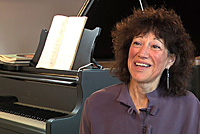Nearly 200 guests filled the Museum of History and Industry’s McEachem Auditorium on June 14 to see the world premiere of Unsilenced, a 40-minute documentary that highlights the 10-year history of Music of Remembrance, and to hear the exquisite music that has inspired musicians and audiences alike.
Unsilenced features performances by local musicians who have worked with MOR, and interviews with Holocaust survivors and MOR supporters.
In attendance for the film’s debut was artistic director, pianist, and MOR founder Mina Miller, music director for the Seattle Symphony Gerard Schwartz, executive producer, writer, and the film’s narrator John Sharify, and former KOMO-TV news reporter Eric Slocum, who gave the introduction and moderated the post-film discussion.
“Our mission is to bring to life the music of banned Jewish composers during the Holocaust,” Miller told JTNews. “There is no one story. Every piece has its own story and the story is extraordinary and heartbreaking.”
The music that made it out of the camps when its composer didn’t often was kept hidden by friends in the camp who safeguarded it and who lived to take it with them.
Miller’s work, whether it is rediscovering archived music and texts, or whether it is commissioning a new work based on a survivor’s story, is a triumph over those who tried to silence it.
“She couldn’t save their lives, but she could save their art,” said Alice Greenwood, an MOR board member who appeared in the documentary.
Unsilenced was a year in the making. Sharify, a multiple Emmy Award-winning broadcaster and former KOMO-TV news reporter who has received international attention for his poignant storytelling style, was introduced to Miller by the MOR board and the pair began the work.
“I wanted a lot of things for this documentary,” Sharify told JTNews. “I wanted to honor those that were murdered, but my job is also to make people “˜feel.’”
Sharify partnered with his longtime associate, videographer and creative director Tim Griffis, to make the film that was shot and edited entirely in Seattle. Sharify hadn’t seen MOR’s work before, but he quickly became impressed by Miller and her mission to bring this music to life.
“With music, it brings [the Holocaust] alive for people in a way that they’ve never felt it before,” Sharify said. “We really had to make sure that whoever is watching the film feels the electricity of the music.”
Many of the highly accomplished classical musicians in Seattle who perform with MOR said in the documentary that for them, there’s no musical experience that compares to performing these compositions.
“There’s nothing like playing this music,” said Laura DeLuca, a clarinetist in the Seattle Symphony, in Unsilenced. DeLuca frequently performs with MOR, and she was the clarinetist for Paul Schoenfield’s MOR commission “Camp Songs.”
“There are very few times when an individual can really change the world,” said Morgan Smith, a musician who performed in Brundìbar, the children’s operetta originally performed at the Terezìn camp by revolving casts of children who were put to death shortly after their performances. The Nazis filmed a performance of Brundìbar in 1944.
The libretto was rewritten in English by playwright Tony Kushner and is now performed around the world.
“Terezìn was all a lie,” said Etta Japha, a 90-year-old survivor of the camp who recalled her time there in an interview for the film. “It was a propaganda effort to convince the world the Jews were being treated well.”
Shortly before the documentary’s premiere last month, Japha died.
Baritone Erich Parce was the stage director for MOR’s 2006 Seattle performance of Brundìbar, which was written by Jewish composer Hans Krasa and performed 55 times by the child prisoners in the camp.
“Oh my God, someone wrote this down in a concentration camp,” said Parce in Unsilenced. Parce is also a frequent performer with MOR. “In Terezìn, in 1942, musicians kept writing and composing, right up until the very end. What we don’t know is what didn’t survive.”
Miller likes to balance MOR’s performances with both old and new pieces. In For a Look or a Touch, another piece highlighted in the documentary, MOR commissioned American opera composer Jake Heggie to write the music. It is the true story of two teen-aged homosexual boys who were to be forever separated from each other by the Nazis. Miller used an archived diary from a young Jewish gay man she found while doing research as her inspiration for the piece.
This new work became Seattle Symphony Director Gerard Schwarz’s first commission for MOR and is available on Naxos Records.
“The community and the country has nothing like this,” Schwarz told the crowd at MOHAI. “It’s a great film and it’s a great story.”
Since 1998, when MOR was founded, several other groups around the world have also begun to perform this music. However, Miller doesn’t believe any more music by Jewish composers who were banned and imprisoned during the Nazi era will surface.
“I’d be surprised if there were new discoveries of music that was composed in the camps at this point,” said Miller. “Our work is actually cultivating people’s interest in digging out their archival materials, whether they are letters or poems.”
MOR hopes to have a DVD of the documentary available this fall.
Silent no more
